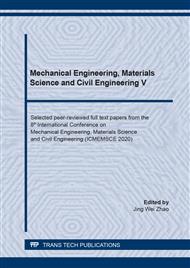[1]
J. N. Reddy, Mechanics of Laminated Composite Plates and Shells, second ed., CRC Press, Florida, (2004).
Google Scholar
[2]
R.M. Jones, Mechanics of Composite Materials, 2nd ed., Taylor & Francis, Philadelphia, (1999).
Google Scholar
[3]
Z.M. Li, P. Qiao, Buckling and postbuckling behavior of shear deformable anisotropic laminated beams with initial geometric imperfections subjected to axial compression, Eng. Struct. 85 (2015) 277–292.
DOI: 10.1016/j.engstruct.2014.12.028
Google Scholar
[4]
A.A. Khdeir, J.N. Reddy, Buckling of cross-ply laminated beams with arbitrary boundary conditions, Compos. Struct. 37 (1997) 1–3.
DOI: 10.1016/s0263-8223(97)00048-2
Google Scholar
[5]
A. Karamanli, M. Aydogdu, Buckling of laminated composite and sandwich beams due to axially varying in-plane loads, Compos. Struct. 210 (2019) 391–408.
DOI: 10.1016/j.compstruct.2018.11.067
Google Scholar
[6]
M. Aydogdu, Buckling analysis of cross-ply laminated beams with general boundary conditions by Ritz method, Compos. Sci. Technol. 66 (2006) 1248–1255.
DOI: 10.1016/j.compscitech.2005.10.029
Google Scholar
[7]
V. Kahya, Buckling analysis of laminated composite and sandwich beams by the finite element method, Compos. Part B Eng. 91 (2016) 126–134.
DOI: 10.1016/j.compositesb.2016.01.031
Google Scholar
[8]
T.P. Vo, H.T. Thai, F. Inam, Axial-flexural coupled vibration and buckling of composite beams using sinusoidal shear deformation theory, Arch. Appl. Mech. 83 (2013) 605–622.
DOI: 10.1007/s00419-012-0707-4
Google Scholar
[9]
R. Jones, Buckling of Bars, Plates, and Shells, Bull Bridge Publishing, Virginia, (2006).
Google Scholar
[10]
J. N. Reddy and R. A. Arciniega, Mechanical and thermal buckling of ceramic–metal plates, in: Woodhead Publishing Series in Civil and Structural Engineering, Woodhead Analysis and Design of Plated Structures, Eds. Woodhead Publishing, 2006, p.147–169.
DOI: 10.1533/9781845690960.147
Google Scholar
[11]
D. Brush and B. Almroth, Buckling of Bars, Plates and Shells, McGraw-Hill, New York, (1975).
Google Scholar
[12]
M. Karama, B.A. Harb, S. Mistou, S. Caperaa, Bending, buckling and free vibration of laminated composite with a transverse shear stress continuity model, Compos. Part B Eng. 29 (1998) 223–234.
DOI: 10.1016/s1359-8368(97)00024-3
Google Scholar


